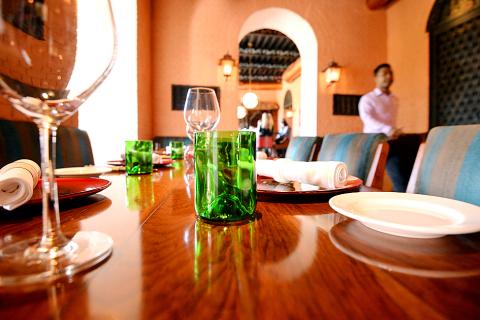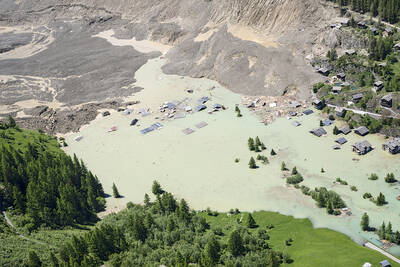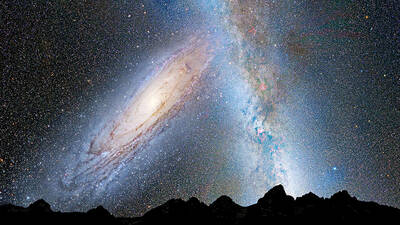A group of tourists sip water at a five-star hotel in Kathmandu, unaware that the green glasses in their hands were once bottles discarded on Mount Everest — left by climbers eager to make their ascent.
In homes across the Nepalese capital upcycled items, from pots to lamps, crafted from Everest waste products are slowly gaining ground as authorities and businesses look for fresh ways to tackle the damage caused by decades of commercial mountaineering.
Tonnes of trash — including empty cans and gas canisters, bottles, plastic and discarded climbing gear — litter the mountain, which has been dubbed the “highest dumpster in the world.”

Photo: AFP
“Waste doesn’t need to be wasted,” said Nabin Bikash Maharjan of local recycling organization Blue Waste to Value (BW2V).
“We received a mix of materials from Everest — aluminum, glass, plastic, iron — much of which could be recycled,” he said, adding: “We need to upcycle and add value to them.”
After heavy criticism for the condition of one of its greatest natural resources, Nepal’s government and mountaineering groups this year organized a six-week cleanup.
Scaling almost 8,000m from base camp to the closest camp to the summit, a 14-strong team retrieved more than 10 tonnes of trash that was flown or driven to recycling centers in Kathmandu.
Workers there manually sorted the materials — each type following a different path to rebirth: Iron was sent to rod manufacturing firms, shredded aluminum cans to utensil makers and discarded bottles re-fashioned into household items.
“Waste is a taboo in our society, considered as dirt,” said Ujen Wangmo Lepcha of Moware Designs, which upcycles rubbish into light fixtures and glasses.
“When they see these kind of products they are like ‘wow,’ these things can be made and it is possible,” she said.
Their products are now used in upmarket hotels, restaurants and homes around the capital, and Lepcha said there is growing consumer interest in goods made from salvaged Everest scraps.
Aanchal Malla, assistant manager at Hotel Yak & Yeti, a luxury five-star hotel in Kathmandu, said that opting for the upcycled goods was in-line with the hotel’s move toward sustainable and environmentally friendly products.
“It is not just better for us and the environment but then it goes way bigger than that … it is encouragement of everyone who is trying to move into that direction of making the globe into a better place, reducing all the waste,” Malla said.
A new waste facility — called Sagarmatha Next after the Nepali name for Everest — is also being completed in Syangboche at an altitude of nearly 3,800m, passed by trekkers and mountaineers on the way to the base camp.
It will process garbage, and collaborate with artists and innovators to make new products in a bid to tap into this burgeoning market for Everest “products.”
However, mountaineers warn that this year’s cleanup collected just a fraction of Mount Everest’s rubbish — with the higher and harder to reach camps still littered by abandoned gear.
Melting glaciers, caused by global warming, are revealing years-old waste, but as the number of climbers attempting to summit soars so do the environmental challenges.
Eleven climbers died in this year’s Everest season, with industry insiders criticizing Nepal for issuing a record 381 permits — leading to high numbers on the mountain and bottlenecks to the summit.
Not all the bodies can be brought down so corpses also lie abandoned on the slopes.

The collapse of the Swiss Birch glacier serves as a chilling warning of the escalating dangers faced by communities worldwide living under the shadow of fragile ice, particularly in Asia, experts said. Footage of the collapse on Wednesday showed a huge cloud of ice and rubble hurtling down the mountainside into the hamlet of Blatten. Swiss Development Cooperation disaster risk reduction adviser Ali Neumann said that while the role of climate change in the case of Blatten “still needs to be investigated,” the wider impacts were clear on the cryosphere — the part of the world covered by frozen water. “Climate change and

Poland is set to hold a presidential runoff election today between two candidates offering starkly different visions for the country’s future. The winner would succeed Polish President Andrzej Duda, a conservative who is finishing his second and final term. The outcome would determine whether Poland embraces a nationalist populist trajectory or pivots more fully toward liberal, pro-European policies. An exit poll by Ipsos would be released when polls close today at 9pm local time, with a margin of error of plus or minus 2 percentage points. Final results are expected tomorrow. Whoever wins can be expected to either help or hinder the

DENIAL: Musk said that the ‘New York Times was lying their ass off,’ after it reported he used so much drugs that he developed bladder problems Elon Musk on Saturday denied a report that he used ketamine and other drugs extensively last year on the US presidential campaign trail. The New York Times on Friday reported that the billionaire adviser to US President Donald Trump used so much ketamine, a powerful anesthetic, that he developed bladder problems. The newspaper said the world’s richest person also took ecstasy and mushrooms, and traveled with a pill box last year, adding that it was not known whether Musk also took drugs while heading the so-called US Department of Government Efficiency (DOGE) after Trump took power in January. In a

It turns out that looming collision between our Milky Way and Andromeda galaxies might not happen after all. Astronomers on Monday said that the probability of the two spiral galaxies colliding is less than previously thought, with a 50-50 chance within the next 10 billion years. That is essentially a coin flip, but still better odds than previous estimates and farther out in time. “As it stands, proclamations of the impending demise of our galaxy seem greatly exaggerated,” the Finnish-led team wrote in a study appearing in Nature Astronomy. While good news for the Milky Way galaxy, the latest forecast might be moot